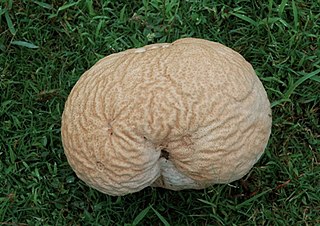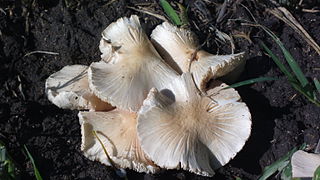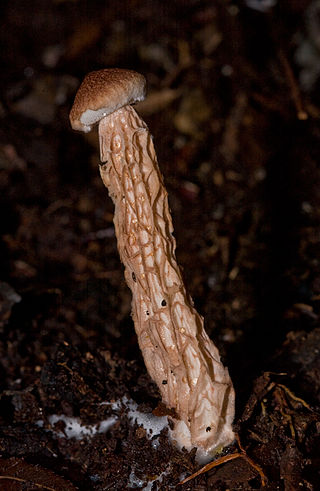
Calvatia is a genus of puffball mushrooms that includes the spectacular giant puffball C. gigantea. It was formerly classified within the now-obsolete order Lycoperdales, which, following a restructuring of fungal taxonomy brought about by molecular phylogeny, has been split; the puffballs, Calvatia spp. are now placed in the family Agaricaceae of the order Agaricales.

Termitomyces, the termite mushrooms, is a genus of basidiomycete fungi belonging to the family Lyophyllaceae. All of which are completely dependent on fungus-growing termites, the Macrotermitinae, to survive, and vice versa. They are the food source for these termites, who enjoy an obligate symbiosis with the genus similar to that between Atta ants and Attamyces mushrooms. Termitomyces mushrooms are edible, and are highly regarded for their flavor.

Gymnopilus purpuratus is a species of agaric fungus in the family Hymenogastraceae. It grows in clusters on dead wood, tree stumps and wood chip mulch. It is widely distributed and has been recorded in Argentina, Australia, Chile, New Zealand, the UK and Germany. It has a broadly convex cap covered in small dry reddish-brown scales, a stout yellow stem beneath reddish brown, wine-red to purple vertical fibres, and a thick rusty orange spore print.

Cymatoderma is a widely distributed genus of poroid fungi in the family Meruliaceae.

George Edward Massee was an English mycologist, plant pathologist, and botanist.
Derek Agutter Reid was an English mycologist.

Podoserpula is a genus of fungi in the family Amylocorticiaceae. The genus contains six species including the type species, P. pusio, commonly known as the pagoda fungus. Species of the genus Podoserpula produce fruit bodies consisting of up to a dozen caps arranged in overlapping shelves, attached to a central axis. Its unique shape is not known to exist in any other fungi. The genus is known to occur in Australia and New Zealand, Venezuela, Madagascar, and New Caledonia.

Geastrum subiculosum is an inedible species of fungus belonging to the genus Geastrum, or earthstar fungi. The fungus was first described scientifically by Cooke and Massee in 1887, based on material found near Trinity Bay, Australia. The fungus grows on decaying wood, and the fruit bodies are characterized by an extensive velvet-like subiculum. The spores are roughly spherical and measure 3.6–4.2 μm. The species is found in Australia, Africa, North America, and South America.

Termitomyces clypeatus species of agaric fungus in the family Lyophyllaceae. Found in Africa, it was formally described by Roger Heim in 1951.

Termitomyces reticulatus is a species of agaric fungus in the family Lyophyllaceae. Found in southern Africa, it was described as new to science in 1990. It is associated with the termite species Odontotermes badius and O. transvaalensis, which are widely distributed in South Africa.

Amanita ochrophylla is a fungus of the family Amanitaceae native to southeastern Australia. Its large and distinctive buff fruit bodies are common after rainfall.

Austroboletus lacunosus is a bolete fungus native to Australia.

Hypholoma brunneum is a species of mushroom in the family Strophariaceae. It was originally described in 1899 by George Edward Massee as Flammula brunnea. Derek Reid transferred it to the genus Hypholoma in 1954.

Termitomyces eurrhizus species of agaric fungus in the family Lyophyllaceae native to Pakistan, India, Sri Lanka, Burma, southwestern China and Malaysia. The fungus has a symbiotic relationship with termites, its mushrooms growing out of mounds after periods of rainfall. It is eaten in Malaysia and the Indian subcontinent.
Cerocorticium molle is a species of crust fungus in the family Meruliaceae.

Macrotermes natalensis is a fungus-growing termite species that belongs to the genus Macrotermes. This species is associated with the Termitomyces fungal genus. M. natalensis has domesticated Termitomyces to produce food for the colony. Both termite species- fungal genus- are obligate and mutually beneficial where termite relies on the fungus to break down for plant materiel and nutrient resource. In contrast, the fungal species obtain plant material and optimal conditions for growth.

Odontotermes is a termite genus belonging to subfamily Macrotermitinae, which is native to the Old World. They are most destructive in wooden homes, and are agricultural pests in the tropics and subtropics of Africa and Asia. It is the most diverse termite genus in Africa, with 78 species recorded.
Lepiota ochrospora is a species of mushroom producing fungus in the family Agaricaceae.














